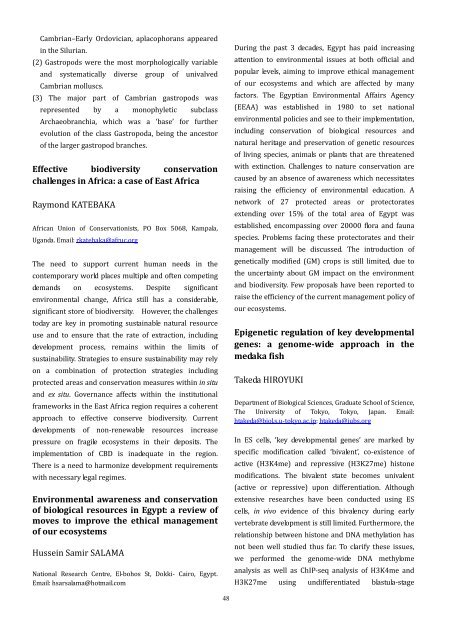Welcome to the 31st IUBS General Assembly and Conference on ...
Welcome to the 31st IUBS General Assembly and Conference on ...
Welcome to the 31st IUBS General Assembly and Conference on ...
Create successful ePaper yourself
Turn your PDF publications into a flip-book with our unique Google optimized e-Paper software.
Cambrian–Early Ordovician, aplacophorans appeared<br />
in <str<strong>on</strong>g>the</str<strong>on</strong>g> Silurian.<br />
(2) Gastropods were <str<strong>on</strong>g>the</str<strong>on</strong>g> most morphologically variable<br />
<str<strong>on</strong>g>and</str<strong>on</strong>g> systematically diverse group of univalved<br />
Cambrian molluscs.<br />
(3) The major part of Cambrian gastropods was<br />
represented by a m<strong>on</strong>ophyletic subclass<br />
Archaeobranchia, which was a ‘base’ for fur<str<strong>on</strong>g>the</str<strong>on</strong>g>r<br />
evoluti<strong>on</strong> of <str<strong>on</strong>g>the</str<strong>on</strong>g> class Gastropoda, being <str<strong>on</strong>g>the</str<strong>on</strong>g> ances<str<strong>on</strong>g>to</str<strong>on</strong>g>r<br />
of <str<strong>on</strong>g>the</str<strong>on</strong>g> larger gastropod branches.<br />
Effective biodiversity c<strong>on</strong>servati<strong>on</strong><br />
challenges in Africa: a case of East Africa<br />
Raym<strong>on</strong>d KATEBAKA<br />
African Uni<strong>on</strong> of C<strong>on</strong>servati<strong>on</strong>ists, PO Box 5068, Kampala,<br />
Ug<str<strong>on</strong>g>and</str<strong>on</strong>g>a. Email: rkatebaka@afruc.org<br />
The need <str<strong>on</strong>g>to</str<strong>on</strong>g> support current human needs in <str<strong>on</strong>g>the</str<strong>on</strong>g><br />
c<strong>on</strong>temporary world places multiple <str<strong>on</strong>g>and</str<strong>on</strong>g> often competing<br />
dem<str<strong>on</strong>g>and</str<strong>on</strong>g>s <strong>on</strong> ecosystems. Despite significant<br />
envir<strong>on</strong>mental change, Africa still has a c<strong>on</strong>siderable,<br />
significant s<str<strong>on</strong>g>to</str<strong>on</strong>g>re of biodiversity. However, <str<strong>on</strong>g>the</str<strong>on</strong>g> challenges<br />
<str<strong>on</strong>g>to</str<strong>on</strong>g>day are key in promoting sustainable natural resource<br />
use <str<strong>on</strong>g>and</str<strong>on</strong>g> <str<strong>on</strong>g>to</str<strong>on</strong>g> ensure that <str<strong>on</strong>g>the</str<strong>on</strong>g> rate of extracti<strong>on</strong>, including<br />
development process, remains within <str<strong>on</strong>g>the</str<strong>on</strong>g> limits of<br />
sustainability. Strategies <str<strong>on</strong>g>to</str<strong>on</strong>g> ensure sustainability may rely<br />
<strong>on</strong> a combinati<strong>on</strong> of protecti<strong>on</strong> strategies including<br />
protected areas <str<strong>on</strong>g>and</str<strong>on</strong>g> c<strong>on</strong>servati<strong>on</strong> measures within in situ<br />
<str<strong>on</strong>g>and</str<strong>on</strong>g> ex situ. Governance affects within <str<strong>on</strong>g>the</str<strong>on</strong>g> instituti<strong>on</strong>al<br />
frameworks in <str<strong>on</strong>g>the</str<strong>on</strong>g> East Africa regi<strong>on</strong> requires a coherent<br />
approach <str<strong>on</strong>g>to</str<strong>on</strong>g> effective c<strong>on</strong>serve biodiversity. Current<br />
developments of n<strong>on</strong>‐renewable resources increase<br />
pressure <strong>on</strong> fragile ecosystems in <str<strong>on</strong>g>the</str<strong>on</strong>g>ir deposits. The<br />
implementati<strong>on</strong> of CBD is inadequate in <str<strong>on</strong>g>the</str<strong>on</strong>g> regi<strong>on</strong>.<br />
There is a need <str<strong>on</strong>g>to</str<strong>on</strong>g> harm<strong>on</strong>ize development requirements<br />
with necessary legal regimes.<br />
Envir<strong>on</strong>mental awareness <str<strong>on</strong>g>and</str<strong>on</strong>g> c<strong>on</strong>servati<strong>on</strong><br />
of biological resources in Egypt: a review of<br />
moves <str<strong>on</strong>g>to</str<strong>on</strong>g> improve <str<strong>on</strong>g>the</str<strong>on</strong>g> ethical management<br />
of our ecosystems<br />
Hussein Samir SALAMA<br />
Nati<strong>on</strong>al Research Centre, El‐bohos St, Dokki‐ Cairo, Egypt.<br />
Email: hsarsalama@hotmail.com<br />
During <str<strong>on</strong>g>the</str<strong>on</strong>g> past 3 decades, Egypt has paid increasing<br />
attenti<strong>on</strong> <str<strong>on</strong>g>to</str<strong>on</strong>g> envir<strong>on</strong>mental issues at both official <str<strong>on</strong>g>and</str<strong>on</strong>g><br />
popular levels, aiming <str<strong>on</strong>g>to</str<strong>on</strong>g> improve ethical management<br />
of our ecosystems <str<strong>on</strong>g>and</str<strong>on</strong>g> which are affected by many<br />
fac<str<strong>on</strong>g>to</str<strong>on</strong>g>rs. The Egyptian Envir<strong>on</strong>mental Affairs Agency<br />
(EEAA) was established in 1980 <str<strong>on</strong>g>to</str<strong>on</strong>g> set nati<strong>on</strong>al<br />
envir<strong>on</strong>mental policies <str<strong>on</strong>g>and</str<strong>on</strong>g> see <str<strong>on</strong>g>to</str<strong>on</strong>g> <str<strong>on</strong>g>the</str<strong>on</strong>g>ir implementati<strong>on</strong>,<br />
including c<strong>on</strong>servati<strong>on</strong> of biological resources <str<strong>on</strong>g>and</str<strong>on</strong>g><br />
natural heritage <str<strong>on</strong>g>and</str<strong>on</strong>g> preservati<strong>on</strong> of genetic resources<br />
of living species, animals or plants that are threatened<br />
with extincti<strong>on</strong>. Challenges <str<strong>on</strong>g>to</str<strong>on</strong>g> nature c<strong>on</strong>servati<strong>on</strong> are<br />
caused by an absence of awareness which necessitates<br />
raising <str<strong>on</strong>g>the</str<strong>on</strong>g> efficiency of envir<strong>on</strong>mental educati<strong>on</strong>. A<br />
network of 27 protected areas or protec<str<strong>on</strong>g>to</str<strong>on</strong>g>rates<br />
extending over 15% of <str<strong>on</strong>g>the</str<strong>on</strong>g> <str<strong>on</strong>g>to</str<strong>on</strong>g>tal area of Egypt was<br />
established, encompassing over 20000 flora <str<strong>on</strong>g>and</str<strong>on</strong>g> fauna<br />
species. Problems facing <str<strong>on</strong>g>the</str<strong>on</strong>g>se protec<str<strong>on</strong>g>to</str<strong>on</strong>g>rates <str<strong>on</strong>g>and</str<strong>on</strong>g> <str<strong>on</strong>g>the</str<strong>on</strong>g>ir<br />
management will be discussed. The introducti<strong>on</strong> of<br />
genetically modified (GM) crops is still limited, due <str<strong>on</strong>g>to</str<strong>on</strong>g><br />
<str<strong>on</strong>g>the</str<strong>on</strong>g> uncertainty about GM impact <strong>on</strong> <str<strong>on</strong>g>the</str<strong>on</strong>g> envir<strong>on</strong>ment<br />
<str<strong>on</strong>g>and</str<strong>on</strong>g> biodiversity. Few proposals have been reported <str<strong>on</strong>g>to</str<strong>on</strong>g><br />
raise <str<strong>on</strong>g>the</str<strong>on</strong>g> efficiency of <str<strong>on</strong>g>the</str<strong>on</strong>g> current management policy of<br />
our ecosystems.<br />
Epigenetic regulati<strong>on</strong> of key developmental<br />
genes: a genomewide approach in <str<strong>on</strong>g>the</str<strong>on</strong>g><br />
medaka fish<br />
Takeda HIROYUKI<br />
Department of Biological Sciences, Graduate School of Science,<br />
The University of Tokyo, Tokyo, Japan. Email:<br />
htakeda@biol.s.u‐<str<strong>on</strong>g>to</str<strong>on</strong>g>kyo.ac.jp; htakeda@iubs.org<br />
In ES cells, ‘key developmental genes’ are marked by<br />
specific modificati<strong>on</strong> called ‘bivalent’, co‐existence of<br />
active (H3K4me) <str<strong>on</strong>g>and</str<strong>on</strong>g> repressive (H3K27me) his<str<strong>on</strong>g>to</str<strong>on</strong>g>ne<br />
modificati<strong>on</strong>s. The bivalent state becomes univalent<br />
(active or repressive) up<strong>on</strong> differentiati<strong>on</strong>. Although<br />
extensive researches have been c<strong>on</strong>ducted using ES<br />
cells, in vivo evidence of this bivalency during early<br />
vertebrate development is still limited. Fur<str<strong>on</strong>g>the</str<strong>on</strong>g>rmore, <str<strong>on</strong>g>the</str<strong>on</strong>g><br />
relati<strong>on</strong>ship between his<str<strong>on</strong>g>to</str<strong>on</strong>g>ne <str<strong>on</strong>g>and</str<strong>on</strong>g> DNA methylati<strong>on</strong> has<br />
not been well studied thus far. To clarify <str<strong>on</strong>g>the</str<strong>on</strong>g>se issues,<br />
we performed <str<strong>on</strong>g>the</str<strong>on</strong>g> genome‐wide DNA methylome<br />
analysis as well as ChIP‐seq analysis of H3K4me <str<strong>on</strong>g>and</str<strong>on</strong>g><br />
H3K27me using undifferentiated blastula‐stage<br />
48
















